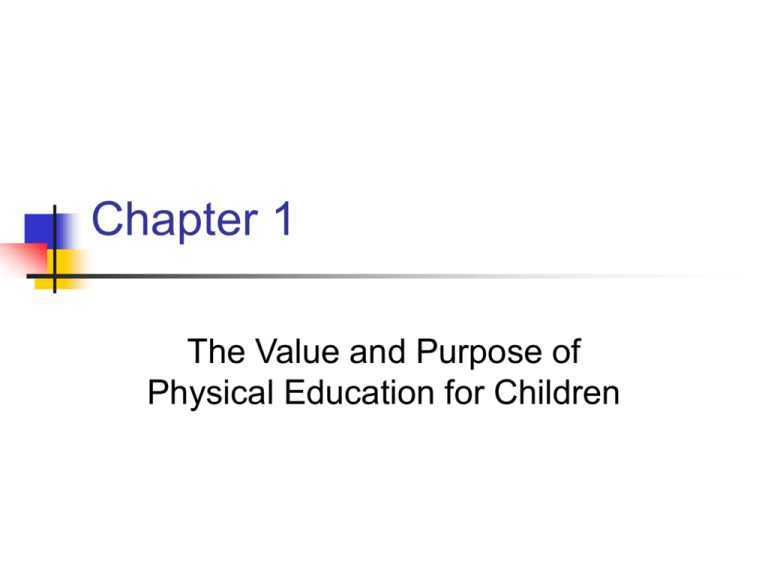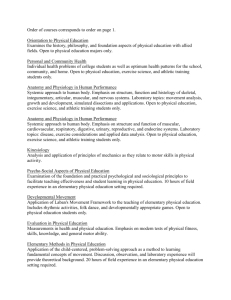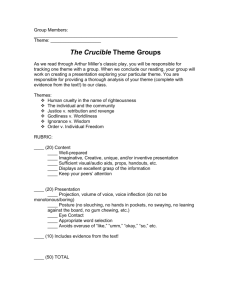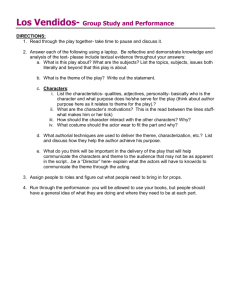Children Moving 6th Edition
advertisement

Chapter 1 The Value and Purpose of Physical Education for Children Group Discussion Why do children need physical education at school? Create a list of four things that your elementary program would emphasize in physical education Did you like physical education when you were in elementary school? Why or why not? Key Points Children have an innate desire to move We need to keep that desire alive by offering opportunities for learning, success and enjoyment of physical activity The Purpose of Physical Education Guide Youngsters in the Process of Becoming Physically Active and Healthy for a Lifetime Key Points Ideally children should be taught by a specialist possessing an extensive background in children’s physical education. National Standards for Physical Education, (NASPE, 2004) define the purpose of a quality program as enabling students to leave school being “physically educated” The Six Content Standards for Physical Education from the National Standards for Physical Education A Physically Educated Person: 1. Demonstrates competency in motor skills and movement patterns needed to perform a variety of physical activities 2. Demonstrates understanding of movement concepts, principles, strategies, and tactics as they apply to the learning and performance of physical activities 3. Participates regularly in physical activity The Six Content Standards for Physical Education (cont) A Physically Educated Person: 4. 5. 6. Achieves and maintains a health-enhancing level of physical fitness Exhibits responsible personal and social behavior that respects self and others in physical activity settings Values physical activity for health, enjoyment, challenge, self-expression, and/or social interaction Benefits of a Quality Physical Education Program 1. 2. 3. 4. 5. 6. 7. 8. 9. 10. Health benefits associated with physical activity and regular participation in physical activity Skill development Improved physical fitness Reinforcement of other subjects Self-discipline Goal setting Leadership and cooperation Enhanced self efficacy Stress reduction Strengthening peer relationships Key Points Consequences of being physically uneducated include having unpleasant memories of physical education experiences and lacking an understanding about what physical activity is Since most children love movement, the challenge to the physical educator is to keep alive the childhood urge to move so that as individuals move into adult years the desire to be physically active is still present Key Points A positive, quality physical education program is: Developmentally appropriate Instructionally appropriate Specific to the children being served Developmentally Appropriate and Instructionally Appropriate Physical Education Developmentally Appropriate Recognizes and promotes children’s changing capacity to move Takes into consideration individual characteristics of children, such as level of development, prior movement experiences, fitness and skill levels, body size and age Instructionally Appropriate Uses best practices that are derived from current research and from experiences teaching children Provides a program that maximizes children’s opportunities to learn and to be successful Characteristics of a positive, quality program Time - at least 150 minutes a week Class size - same as the regular classroom Sequential, developmental curriculum - scope and sequence of curriculum connected to past and future lessons and children's developmental levels Minimum of 50% moderate to vigorous Activity (MVPA) during each lesson Practice opportunities - many opportunities to practice skill/concept being taught Characteristics of a positive, quality program (cont) High rates of success - for children at all ability levels Positive developmental environment - children should feel emotionally safe in the physical education environment Teacher background - ideally, the teacher should have extensive background in content and pedagogy of physical education Realistic expectations - if time is limited for physical education, teachers set realistic goals to help develop motor skills so that children can successfully participate in physical activities Characteristics of a positive, quality program (cont) Adequate equipment and facilities - ideally, a variety of equipment for all children and both indoor an outdoor facilities Enjoyable - learning should be fun! Emphasize the psychomotor domain, but also focus on the cognitive and affective domains Vignette #1 The PE teacher, Ms. Jones, likes basketball and is the assistant coach at the middle school. She spends 6 weeks each year on a basketball unit with the 4th and 5th grade students. The unit includes skill drills the first week and then teams playing 5 on 5, with a round robin tournament the last week. Vignette #2 Mr. Rader, a third grade classroom teacher, is responsible for providing physical education to his students at least 2 times a week. One day he plans 30 minutes of simple games, and the other day he gives ‘free time’ with a variety of manipulative equipment, such as balls, hoops, ropes, etc. Vignette #3 Two classroom teachers ask the physical education teacher to take both their classes at the same time on Fridays for 4 weeks so that they can have a planning time together. The classes would be in a small multipurpose room. Mr. Smith doesn’t know what they are planning together, only that it is an interdisciplinary school project. Small Group Work Write a mission statement for your elementary physical education program Present your mission statement to the class Chapter 2 The Skill Theme Approach Key Points Skill Themes are: Fundamental movements, later modified into more specialized patterns upon which more complex activities/sports are built. The Skill Theme Approach is a way of teaching physical education that: • Is organized around Skill Themes and Movement concepts Key Points Important motor development principles: Children develop at different rates Age does not predict motor ability Children develop motor skills naturally through play Skillfulness is a result of practice, not gender or heredity The Curriculum Diamond Key Points Curriculum Diamond Suggests the development of a broad foundation of movement forms at the elementary and middle school level focus on proficiency in few movements at high school Key Points Elementary Level Focus: To help children acquire the fundamental competencies: • First focus on developing movement concepts – Space awareness – Effort – Relationships • Then focus on developing skill themes – Manipulative skills – Locomotor skills – Non-manipulative skills Active Learning Time Generate a list of sports/physical activities taught in physical education. Choose four different sports/activities List all of the psychomotor skills necessary to successfully participate What psychomotor skills do these sports/activities have in common? Key Points Skill theme approach Emphasizes helping children develop skill competencies that enable them to participate successfully with enjoyment. Provides different tasks based on children’s ability Four skill levels: precontrol, control, utilization, proficiency Focuses on children learning the critical elements of a skill. Key Points Additional Skill Theme Approach qualities: Emphasizes both cognitive and affective domains by helping children understand the “how’s” and “why’s” of movement and giving them opportunities to feel good about themselves and others Skill themes may be revisited throughout the school year many times Comparing the Skill Theme Approach with the Traditional Method of Teaching Physical Education Skill Theme Approach Traditional Method Primary emphasis on fundamental motor skill acquisition and competency Primary emphasis on teaching children games, dances, and gymnastics without regard to skill acquisition. Primary emphasis on providing learning experiences that are appropriate for the developmental level of the individual child Primary emphasis on providing learning experiences that are based on the child’s age or grade Scope and sequence is designed to reflect the needs and interests of the students over a period of years (i.e.,K-5) Scope and sequence is designed to teach skills in preset “units” of three weeks, six weeks, etc Practical Application Using the skill theme of dribbling a ball, how could a teacher adjust the activity to be ‘developmentally appropriate’ for children of varying ability levels?






